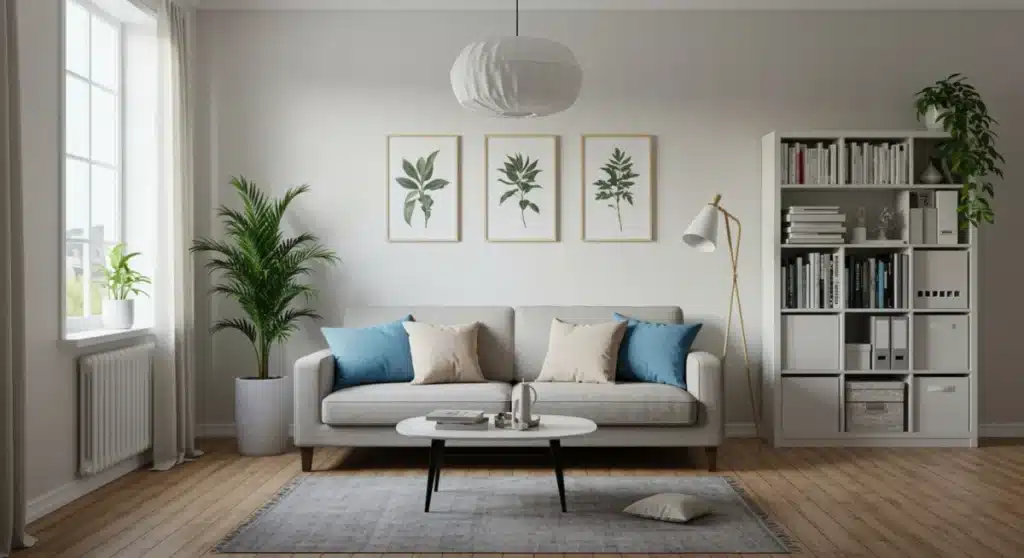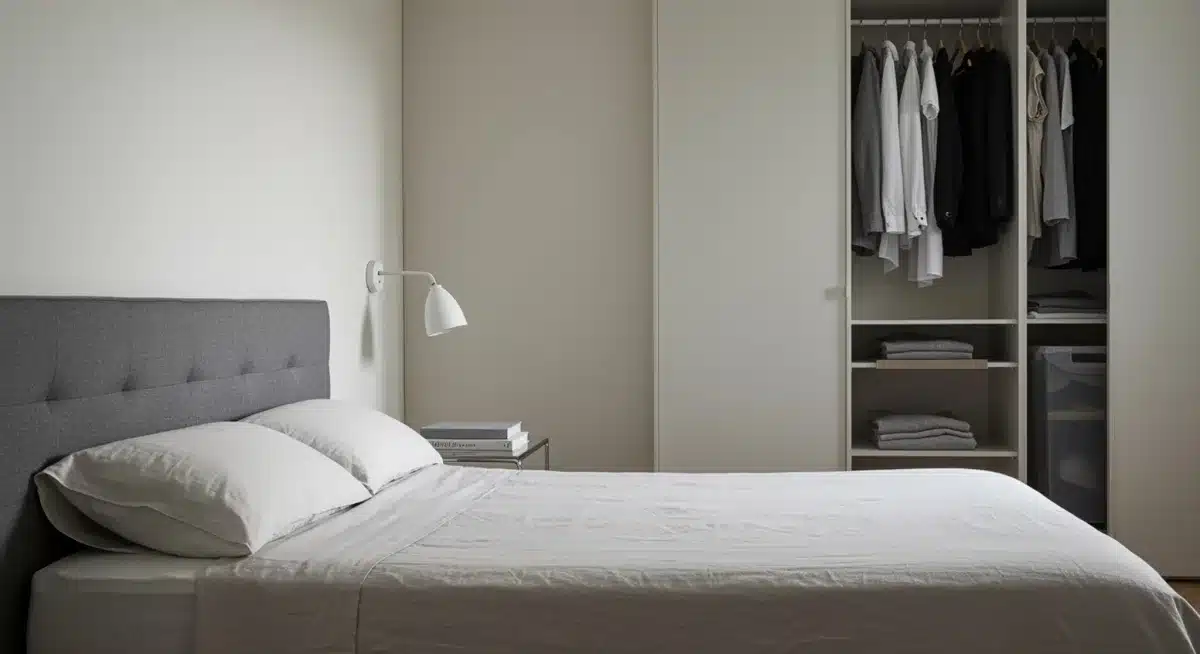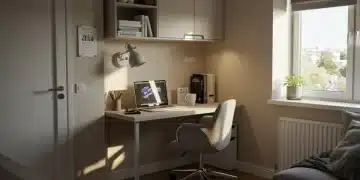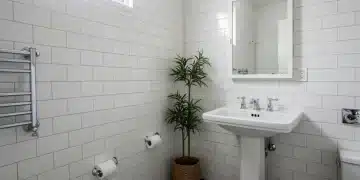Declutter Your Home in 30 Days: A Step-by-Step Guide

Implementing a structured 30-day plan can effectively transform a cluttered home into an organized, functional, and peaceful living space, fostering a sense of control and reducing daily stress.
Are you feeling overwhelmed by clutter, longing for a serene and functional living space? It’s time to take control! This comprehensive guide will show you how to Declutter Your Life: How to Organize Your Home in Just 30 Days, transforming your environment and fostering a greater sense of peace and productivity.
Understanding the Impact of Clutter on Your Well-being
Clutter is more than just physical mess; it often mirrors and contributes to mental and emotional disarray. The constant visual noise and the effort required to navigate through unorganized spaces can significantly impact your daily life, leading to increased stress, decreased productivity, and a general feeling of being overwhelmed.
Recognizing the profound effects of a cluttered environment is the first step toward embracing a more organized lifestyle. It’s not merely about aesthetics; it’s about reclaiming your mental clarity and creating a sanctuary where you can truly relax and thrive.
The Psychological Toll of Disorganization
A disorganized home can be a constant source of low-level stress. Researchers have found direct links between cluttered environments and heightened cortisol levels, the body’s primary stress hormone. This can manifest as:
- Increased anxiety and difficulty relaxing.
- Reduced focus and concentration.
- Feelings of guilt or shame about your living space.
- Difficulty making decisions, even small ones.
Moreover, the energy spent searching for misplaced items or constantly tidying up without truly organizing can drain your mental reserves, leaving you exhausted before your day even truly begins. Understanding these impacts provides powerful motivation to embark on a decluttering journey.
The Benefits of an Organized Environment
Conversely, an organized home offers a multitude of benefits that extend far beyond a tidy appearance. When your surroundings are orderly, your mind tends to follow suit. This can lead to:
- Enhanced mental clarity and improved decision-making.
- Reduced stress and anxiety, fostering a sense of calm.
- Increased productivity and efficiency, as items are easy to find.
- Greater satisfaction and pride in your living space.
Embracing organization is an investment in your overall well-being, creating a foundation for a more harmonious and fulfilling life. It allows you to focus on what truly matters, rather than being constantly distracted by disarray.
By delving into the psychological and practical implications of clutter, we begin to appreciate the transformative power of a well-organized home. This understanding sets the stage for a successful 30-day decluttering challenge, equipping you with the motivation needed to see it through.
Preparing for Your 30-Day Decluttering Journey
Embarking on a 30-day decluttering challenge requires more than just good intentions; it demands thoughtful preparation. Setting yourself up for success involves creating a clear plan, gathering the necessary tools, and cultivating the right mindset. This foundational work will ensure your efforts are efficient and sustainable, preventing burnout and maximizing your progress.
A well-prepared start can make all the difference in achieving your goal to declutter your home in 30 days. It transforms a daunting task into a manageable series of steps.
Setting Realistic Goals and Expectations
Before you even touch an item, define what ‘decluttered’ means to you. Is it a minimalist haven, or simply a space where everything has a home and is easy to find? Setting realistic, achievable goals is crucial. Don’t aim for perfection overnight, but rather consistent progress. Break down your ultimate vision into smaller, daily objectives.
- Define your ‘why’: What specific benefits do you seek from a decluttered home?
- Visualize your ideal space: How do you want each room to feel and function?
- Start small: Don’t try to tackle your entire attic on day one.
Remember, this is a journey, not a sprint. Celebrate small victories along the way to maintain momentum and motivation.
Gathering Your Decluttering Toolkit
Having the right supplies on hand will streamline the process. You don’t need expensive organizers from the start; focus on basic tools that facilitate sorting and disposal.
- Boxes or bins: Label them ‘Keep,’ ‘Donate,’ ‘Trash,’ ‘Relocate.’
- Trash bags: For obvious waste.
- Cleaning supplies: To clean surfaces once items are removed.
- Timer: To keep sessions focused and prevent overwhelm.
- Notebook and pen: For tracking progress and making notes.
Consider creating a dedicated ‘donation’ station where items can accumulate until you’re ready to drop them off. This prevents them from simply migrating to another corner of your home.
Mental preparation is just as vital as physical preparation. Acknowledge that the process might stir up emotions, especially when dealing with sentimental items. Be kind to yourself, and remember your ‘why.’ By meticulously preparing, you lay a solid groundwork for a transformative 30-day journey towards an organized home.
The First Week: Kicking Off Your Decluttering Journey
The first week of your 30-day challenge is critical for building momentum and establishing healthy habits. We’ll focus on high-impact areas that often accumulate clutter quickly and are relatively easier to tackle, giving you quick wins and boosting your confidence. This initial phase is designed to be manageable, preventing burnout while setting a strong foundation for the weeks to come.
Starting with visible and frequently used areas helps you see immediate results, inspiring you to continue your mission to declutter your home in 30 days effectively.
Day 1-3: The Entryway and Living Room
Begin with the spaces that create first impressions and are central to daily life. The entryway often becomes a dumping ground for shoes, coats, mail, and keys. The living room, as a communal space, can quickly accumulate various items.
- Entryway: Sort through shoes, coats, bags, and mail. Install hooks or a small shelf if needed.
- Living Room Surfaces: Clear coffee tables, end tables, and shelves. Remove anything that doesn’t belong or isn’t actively used.
- Media and Electronics: Organize remotes, charging cables, and entertainment system components.
Focus on decluttering horizontal surfaces first, as this immediately creates a sense of openness and order. For each item, ask yourself: ‘Do I need it? Do I use it? Does it belong here?’
Day 4-7: The Kitchen Countertops and Pantry
The kitchen, often called the heart of the home, can also be a major source of clutter. Start with the most visible and frequently used areas: countertops and the pantry.
Clear all countertops, putting away small appliances you rarely use. Wipe down surfaces. Then, move to the pantry. Remove expired items, consolidate duplicates, and group similar items together. Consider using clear containers or labels for better visibility.

This week’s efforts will significantly reduce visible clutter, making your home feel lighter and more welcoming. The momentum gained will be invaluable for the subsequent weeks of your decluttering journey. Remember to donate or dispose of items promptly to avoid creating new piles.
By systematically addressing these high-traffic areas, you’ll not only see tangible results but also begin to internalize the decision-making process required for effective decluttering. This initial success will fuel your motivation for the remaining weeks of your 30-day challenge.
Week Two: Deep Dive into Personal Spaces
As you enter week two, the focus shifts to more personal and often more challenging areas: bedrooms and bathrooms. These spaces tend to hold a higher concentration of sentimental items and personal care products, requiring a more thoughtful approach. The goal for this week is to create functional, calming sanctuaries where you can truly unwind and prepare for your day.
Tackling these intimate areas is a crucial step in your journey to declutter your home in 30 days, as it directly impacts your daily routines and personal sense of order.
Day 8-11: The Bedroom Sanctuary
Your bedroom should be a place of rest and rejuvenation, not a storage unit. Begin by stripping the room down to its essentials. Focus on clothing, accessories, and bedside tables.
- Wardrobe Purge: Take out all clothes. Employ the ‘KonMari’ method or a similar system: keep only items that fit well, make you feel good, and are currently in style for you. Donate or sell what you no longer need.
- Dressers and Nightstands: Clear all surfaces. Keep only essentials on nightstands (a book, a lamp, perhaps a glass of water). Declutter drawers, removing old papers, expired medications, or miscellaneous trinkets.
- Under the Bed/Closet Floor: Address these often-neglected storage spots. Remove anything not actively used or stored properly.
Creating a capsule wardrobe concept, even loosely, can significantly reduce clothing clutter and simplify your daily routine. The less you have, the easier it is to maintain.
Day 12-14: Bathroom Bliss
Bathrooms, despite their small size, can accumulate an astonishing amount of products. These spaces need to be functional and hygienic above all else.
- Medicine Cabinet/Under Sink: Remove all expired medications, cosmetics, and toiletries. Be ruthless with products you’ve tried and disliked.
- Linens: Keep only the towels and washcloths you actively use. Donate or repurpose old, worn-out ones.
- Shower/Tub: Limit products to those you use daily. Consider a shower caddy for organization.
Once decluttered, organize remaining items into categories (skin care, hair care, dental care) and use small bins or drawer dividers to keep them tidy. This week’s focus on personal spaces will bring a profound sense of calm and efficiency to your daily routines, reinforcing the benefits of your 30-day decluttering commitment.
The transformation of these private areas is often the most rewarding, as it directly impacts your personal comfort and ability to relax within your own home. By the end of week two, you’ll feel a tangible shift in your environment and your mindset.
Week Three: Conquering Storage and Specialized Areas
Week three is dedicated to tackling the often-overlooked and sometimes intimidating storage areas and specialized rooms. These spaces, such as home offices, laundry rooms, and utility closets, can become black holes for miscellaneous items. This week requires a methodical approach, as these areas often house items that are used less frequently but are still important.
Successfully organizing these zones is a significant milestone in your journey to declutter your home in 30 days, ensuring that even hidden spaces contribute to overall order.
Day 15-18: The Home Office or Workspace
A tidy workspace is crucial for productivity and focus. This area often accumulates papers, old electronics, and office supplies.
- Paper Piles: Sort through all documents. Shred unnecessary papers, file important ones, and digitize anything you can. Implement a ‘touch it once’ rule for incoming mail.
- Desk and Drawers: Clear your desk surface, keeping only essential items. Organize drawers with dividers for pens, clips, and other supplies.
- Electronics and Cables: Untangle and organize charging cables, old devices, and accessories. Discard or recycle what’s broken or obsolete.
Consider a simple filing system for papers you must keep. A digital organization system can also significantly reduce physical paper clutter, making your workspace more streamlined and efficient.
Day 19-21: Laundry Room and Utility Closets
These functional spaces, while not glamorous, benefit immensely from organization. They are often repositories for cleaning supplies, tools, and seasonal items.
- Laundry Room: Consolidate detergents, fabric softeners, and other laundry products. Ensure all items are easily accessible. Clean out lint traps and wipe down surfaces.
- Utility Closets: Remove all items and sort through them. Discard empty containers, broken tools, or anything that hasn’t been used in years. Group similar items together (e.g., lightbulbs, batteries, tools).
- Seasonal Items: If these areas store seasonal decorations or clothing, ensure they are properly labeled and stored in appropriate containers.
Utilize vertical space in these areas with shelving or wall-mounted organizers. This maximizes storage without creating new piles. By the end of week three, you’ll have tackled some of the most challenging areas, leaving only the final touches for the last week. The sense of accomplishment will be immense as your entire home begins to reflect your commitment to an organized life.
Week Four: Fine-Tuning and Maintaining Your Organized Home
The final week of your 30-day decluttering challenge is about refining your efforts and establishing routines for long-term maintenance. This phase is crucial for ensuring that the hard work you’ve put in doesn’t unravel. It involves addressing remaining odds and ends, optimizing storage solutions, and most importantly, developing habits that support an organized lifestyle.
This week solidifies your progress and empowers you to keep your decluttered home in 30 days a reality, rather than a temporary state.
Day 22-25: Sentimental Items and Digital Declutter
These days are dedicated to items that often evoke strong emotions and to the invisible clutter that can weigh us down.
- Sentimental Items: Gather all sentimental items (photos, mementos, heirlooms). Choose a select few that truly bring joy or hold significant meaning. Digitize photos if possible. Create a dedicated memory box for cherished items.
- Digital Declutter: Tackle your computer desktop, email inbox, and phone apps. Delete unnecessary files, unsubscribe from unwanted emails, and organize digital photos into folders.
Dealing with sentimental items can be emotionally taxing. Give yourself permission to keep a few treasured pieces, but remember that memories reside in your heart, not necessarily in every physical object. Digital clutter, though unseen, can be just as overwhelming as physical clutter, impacting your productivity and peace of mind.
Day 26-28: Optimizing Storage and Final Touches
Now that you’ve decluttered, it’s time to ensure everything has a logical and accessible home. This is where organization tools become truly effective.
- Storage Solutions: Invest in appropriate storage containers, drawer dividers, and shelving units where needed. Ensure they fit your space and needs.
- Labeling: Label bins, shelves, and files clearly. This makes it easy to find items and put them back in their designated spots.
- One Last Sweep: Do a quick walkthrough of each room. Are there any lingering items? Is anything out of place? This is your final opportunity to catch anything you missed.
The goal is to create a system that is intuitive and easy to maintain. When everything has a place, tidying up becomes a quick and simple task rather than a major undertaking.
Day 29-30: Establishing Maintenance Routines and Celebrating Success
The final days are about celebrating your achievement and planning for the future. The real challenge is not just decluttering, but staying decluttered.

- Daily Tidy-Up: Implement a 10-15 minute daily tidy-up routine. Put things back in their place before bed.
- Weekly Reset: Dedicate an hour each week to reset your home, addressing any accumulating clutter or tidying tasks.
- Seasonal Declutter: Plan for a deeper decluttering session once or twice a year to reassess belongings and prevent accumulation.
- Celebrate: Acknowledge your hard work! Treat yourself to something non-material, like a relaxing bath, a walk in nature, or a meal with loved ones.
By establishing these routines, you ensure that your home remains a haven of peace and order. You’ve not just decluttered your home in 30 days; you’ve cultivated a new lifestyle that promotes well-being and efficiency. Congratulations on a job well done!
| Key Phase | Brief Description |
|---|---|
| Week 1: High-Impact Areas | Focus on entryways, living rooms, and kitchen countertops for quick wins and motivation. |
| Week 2: Personal Spaces | Tackle bedrooms and bathrooms, addressing clothing, toiletries, and personal items. |
| Week 3: Storage & Specialized | Conquer home offices, laundry rooms, and utility closets, including paper and tools. |
| Week 4: Refine & Maintain | Address sentimental and digital clutter, optimize storage, and establish maintenance routines. |
Frequently Asked Questions About Decluttering
The most effective first step is to choose one small, manageable area, like a single drawer or countertop, and completely clear it. This quick win builds confidence and momentum, making the larger task of decluttering your home in 30 days feel less daunting and more achievable.
When encountering sentimental items, create a dedicated ‘memory box’ for a select few truly cherished pieces. For others, consider digitizing photos or creating a photo album. Remember, memories reside in your heart, not necessarily in every physical object, allowing you to let go without losing the sentiment.
To prevent re-cluttering, establish daily and weekly tidy-up routines, like a 15-minute evening sweep. Implement a ‘one in, one out’ rule for new purchases. Regularly reassess your belongings and avoid impulse buys, ensuring your organized home remains sustainable long-term.
While some prefer category-based decluttering (e.g., all clothes at once), for a 30-day home organization challenge, a room-by-room approach is often more practical. It allows for immediate visual progress in specific areas, maintaining motivation and making the process feel less overwhelming for beginners.
If you feel overwhelmed, take a break. Revisit your ‘why’ for decluttering. Break tasks into even smaller chunks, perhaps just 10-15 minutes a day. Celebrate small achievements and remind yourself that progress, not perfection, is the goal. Consistency is key to success in your 30-day journey.
Conclusion
Embarking on a journey to declutter your home in just 30 days is a transformative experience, extending far beyond simply tidying up. This comprehensive guide has provided a structured, week-by-week plan to systematically address every area of your home, from high-traffic zones to personal sanctuaries and often-neglected storage spaces. By committing to this process, you not only create a more organized and functional living environment but also cultivate a profound sense of peace, clarity, and control in your daily life. The benefits of a decluttered home are immense, contributing to reduced stress, enhanced productivity, and a greater sense of well-being. Remember that maintaining this newfound order requires establishing consistent habits and a mindful approach to consumption. As you celebrate the completion of your 30-day challenge, you’ll find that you haven’t just organized your home; you’ve invested in a healthier, happier version of yourself. Embrace this positive change and enjoy the lasting tranquility that a well-ordered home brings.





